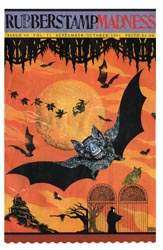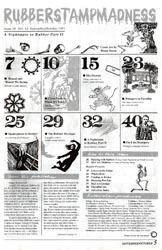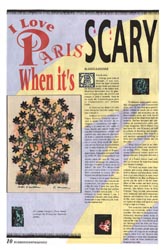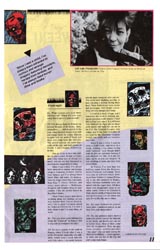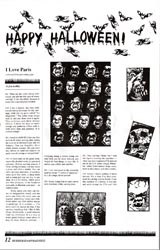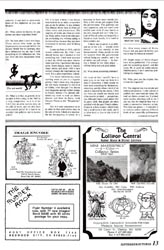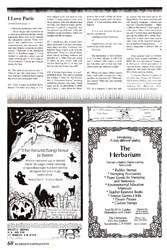RubberStampMadness
issue 59 vol 12 - sept/oct 1991
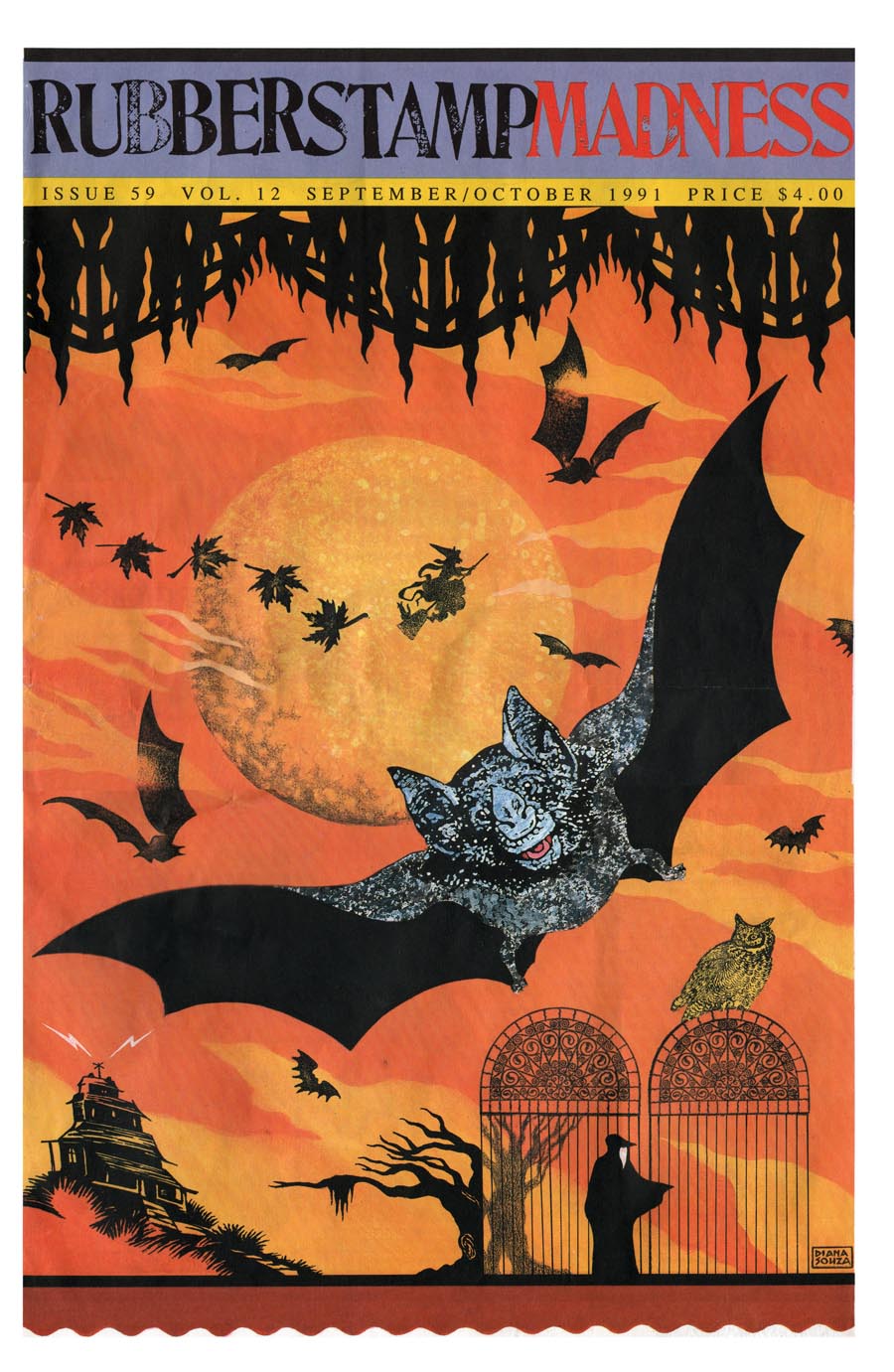
French artist.
Change your train of thought, if you will, from the light-drenched poppy fields and skies of the Impressionists, to the darker side. Blackness interrupted only by glimmers of bright colors, the yellows and oranges of jack-o'-lanterns' faces in the night, the fluorescent green glow of Frankensteins and Dracula masks... If Hallowe'en didn't already exist, Francoise Duvivier would have had to invent it. Hallowe'en is not celebrated in France. However, Françoise has created a niche for herself in its imagery -- expanding and embellishing it to create her own world of faces, figures and natural forms. Her macabre mask/portraits, twisted and gnarled trees and ghoulish skeletons all share a common strength in their mystery, bold linework and original use of color. They recall the woodcuts of the german Expressionists and, in some respects, Art Nouveau. Born in the north of France, near Calais, Françoise moved to Paris in 1978-79. She discontinued her studies when she was 20. "My parents didn't encourage me artistically, although I wanted to study in an art school," she says. "I've always made art, since I was a child — I've always been attracted to create. It's the biggest friendship I know in life. "I have a lot of good childhood memories. My best ones concern the countryside, the animals and especially the cats. I have two cats, Pam and Poum. Not having had serious studies, I've had various jobs — I'm obliged to work where I can. I worked in a factory, then in an office. Sometimes I stay without a job, looking for another one." Traditional employment aside, this imaginative and resourceful artist, now 35, has been quite prolific in her efforts to reach out to other artists, writers and musicians, on an international scale, and both inside and outside of the established mail art network. She has designed and published an international audio and visual magazine, Metro Riquet (the last issue, #8, was 90 pages), as well as a book of drawings and poetry, L'Écran Caverneux. She lives in a tall, modern apartment building in Paris with her friend Claude and her two cats. What follows here is an interview-by-mail which was conducted in spring 1991. Along with the stamp-illustrated letters, notes and photos she sent, Frangoise also sent a copy of a French picture book entitled Le Carnaval, by Jean-Yves Simon and Jacques Lerouge. The book has many color illustrations and stories about carnivals held in Europe and elsewhere, which bear close resemblance in some ways to our Hallowe'en. But, as Francoise points out, the spirit is not the same. Most of the events are held during February and attended by large crowds, like Mardi Gras in New Orleans. They include processions with drummers and other musicians, dancers and marchers from all walks of life, some supporting large, painted figures of kings and queens, towering as high as a house. The costumes tend to be more ribald and clownish, rather than macabre. The ends of the parades traditionally involve some kind of chanting, taunting or mockery, dating back to the Fete de L'Ane (Festival of the Donkey) and the Fête des Fous (Festival of Fools) in early Christianity, when the common people used the anonymity of disguise to exchange cultural roles with the "powers that be," perhaps to voice their discontent. Sadly, many of these carnivals are disappearing today.
Change your train of thought, if you will, from the light-drenched poppy fields and skies of the Impressionists, to the darker side. Blackness interrupted only by glimmers of bright colors, the yellows and oranges of jack-o'-lanterns' faces in the night, the fluorescent green glow of Frankensteins and Dracula masks... If Hallowe'en didn't already exist, Francoise Duvivier would have had to invent it. Hallowe'en is not celebrated in France. However, Françoise has created a niche for herself in its imagery -- expanding and embellishing it to create her own world of faces, figures and natural forms. Her macabre mask/portraits, twisted and gnarled trees and ghoulish skeletons all share a common strength in their mystery, bold linework and original use of color. They recall the woodcuts of the german Expressionists and, in some respects, Art Nouveau. Born in the north of France, near Calais, Françoise moved to Paris in 1978-79. She discontinued her studies when she was 20. "My parents didn't encourage me artistically, although I wanted to study in an art school," she says. "I've always made art, since I was a child — I've always been attracted to create. It's the biggest friendship I know in life. "I have a lot of good childhood memories. My best ones concern the countryside, the animals and especially the cats. I have two cats, Pam and Poum. Not having had serious studies, I've had various jobs — I'm obliged to work where I can. I worked in a factory, then in an office. Sometimes I stay without a job, looking for another one." Traditional employment aside, this imaginative and resourceful artist, now 35, has been quite prolific in her efforts to reach out to other artists, writers and musicians, on an international scale, and both inside and outside of the established mail art network. She has designed and published an international audio and visual magazine, Metro Riquet (the last issue, #8, was 90 pages), as well as a book of drawings and poetry, L'Écran Caverneux. She lives in a tall, modern apartment building in Paris with her friend Claude and her two cats. What follows here is an interview-by-mail which was conducted in spring 1991. Along with the stamp-illustrated letters, notes and photos she sent, Frangoise also sent a copy of a French picture book entitled Le Carnaval, by Jean-Yves Simon and Jacques Lerouge. The book has many color illustrations and stories about carnivals held in Europe and elsewhere, which bear close resemblance in some ways to our Hallowe'en. But, as Francoise points out, the spirit is not the same. Most of the events are held during February and attended by large crowds, like Mardi Gras in New Orleans. They include processions with drummers and other musicians, dancers and marchers from all walks of life, some supporting large, painted figures of kings and queens, towering as high as a house. The costumes tend to be more ribald and clownish, rather than macabre. The ends of the parades traditionally involve some kind of chanting, taunting or mockery, dating back to the Fete de L'Ane (Festival of the Donkey) and the Fête des Fous (Festival of Fools) in early Christianity, when the common people used the anonymity of disguise to exchange cultural roles with the "powers that be," perhaps to voice their discontent. Sadly, many of these carnivals are disappearing today.
-RubberStampMadness:KL: What interests you most about Hallowe'en? When did you start using that imagery in your artwork?
-Françoise Duvivier:
I've always liked the Hallowe'en holiday because of its masks, faces, atmosphere . . . and its period in the year, when the earth begins to be cold and sleeps, ready for winter. You can imagine well the spirit of Death and those who come back and visit you. This period reminds you most especially of the past, and dead parents or friends. I can't imagine Hallowe'en in July.
You are lucky to have this holiday in your country. People in France don't like [that sort of thing] too much, and are not that interested in anything too imaginative or crazy.
Since I was a child, I've always been attracted to curious and strange imagery featuring monsters, heroes from fantasy, and I've always liked horror films and books, for instance, those by Edgar Allan Poe, Lovecraft, Jean Ray, T. Owen, Tolkien, and many, many others -- Matheson, Sturgeon and Stephen King in your country. I like the morbid humor in Jean Ray's books.
Most French people don't know anything about this holiday, so you may wonder how I know about it, why I like it, since I've never visited the States on Hallowe'en. I've read a little about it and I've seen films, no more. -RubberStampMadness:KL: Can you share some information about the "Carnaval" in France? Did it originate as a religious holiday?
-Françoise Duvivier:
It's more popular in the north of France, where I lived when I was a child. Everyone, especially the children, would wear a mask and talk with little voices, very nasal, because nobody must recognize who you are. You could wear anything you like. A man can play a woman during these days. These festivals are more coarse and grotesque, with bright colors. They are very baroque and funny.
I lived in a small village, and I remember the masked children asking for pancakes in the houses. I liked this holiday very much. It is different from Hallowe'en; there are not those same masks and faces we can see in the U.S. The Carnaval is pagan, very vulgar, and it has been forbidden in the past by the Christian religion. People can drink and eat however they want.
When I was a child, I used to wear a death mask, and dress in a frock, holding a big chain during these "carnaval" days. People didn't want to give me pancakes because I was dressed like this. It is not the same spirit, as you can imagine. It was shocking to them, and they were afraid of me.
In France, I've read that this holiday came from the Romans, before Christian civilization. There were lots of different feasts (holidays) from October to January/February in the old centuries in France, when Christian traditions were still mixed with the pagan ones. All these feasts have disappeared today in our urban world. There is no Carnaval in Paris and the north of France has also lost its Carnaval, full of colors and joys. It was like the sun in winter.
-RubberStampMadness - KL: Do your Hallowe'en portrait faces show a particular person, or are they from your imagination?
-Françoise Duvivier:
No, my portraits don't show a particular person except for Dracula, or the devils and heroes you can see in horror films. Most of them come from the imagination. They are ugly faces, monsters, zombies and other "nice guys" you can meet during the Hallowe'en holiday — most especially when you are lost in the fog and can't come back home.
-RubberStampMadness - KL: What are the color inking techniques you use for this type of eraser carving? I like the effect, because it looks like a stained glass window.
-Françoise Duvivier:
I use a special, not very well-known inking technique for my carvings, with felt tip pens called "Le Magicien." You color your image with it, and you draw over it again. This technique gets these strange effects. I think we may do more strange and particular effects with it, with more time and patience. It is curious enough.
-RubberStampMadness - KL: I read [in RSM #51] that you first learned of eraser carving after seeing the mail art of Michael Leigh and Art Nahpro. You use Staedtler Mars white plastic erasers. Do you have any advice to send our readers on good rules of carving or composition?
-Françoise Duvivier:
It takes time to do good work, especially detailed work, so you need patience. Before carving erasers, I liked carving linoleum, but that needs a press and often a studio. You can carve an eraser anywhere, if you have some good lino tools, a sharp knife and a stamp pad you can buy in any shop. It's a fun hobby, which gives you this pleasure, to do beautiful postcards, to illustrate your mail — to communicate.
Every stamp you have can create an imaginative world, and the more you have, the more you can express something varied and rich. Some artists use their rubber stamps in paintings. It is curious -- I've never used my stamps for that. I like carving everything that I like in life, things which evoke a good memory from my childhood. It is a way to make good feelings come alive. It may be trees, flowers, animals. . . Carrying along a rubber stamp can only help you be more relaxed, and forget the bad things in your life. It makes you a child, and carefree.
-RubberStampMadness - KL: I am interested in the materials used to create "L'Arbre d'Automne." Is it all stamps, hand-carved?
-Françoise Duvivier:
Every stamp I do is hand-carved with lino tools. I like carving trees.
-RubberStampMadness - KL: Your carving "Body Art," with the figures forming the alphabet - what was your inspiration? It reminds me of the U.S. dance troupe, Pilobolus, which forms human shape-sculptures as they dance, with their bodies.
-Françoise Duvivier:
Indeed, I know nothing of those dancers. For a time, I've been interested in carving curious letters. I saw this alphabet in a library. It was old, and used during the 17th and 18th centuries. It was hard to carve every letter of this alphabet, as you can imagine.
-RubberStampMadness - KL: What artists in history do you admire and draw inspiration from?
-Françoise Duvivier:
The first artist I liked was Goya. Those artists who made up the Expressionist movement before the Second World War in Germany, they have influenced my art, but I think everything in life influences me. You can draw the best inspiration from life.
-RubberStampMadness - KL: What is it like, in general, to be an artist in Paris today, in the '90s? Is it very competitive, as it is in the U.S.? Can an artist survive only on the sale of work, and not also have some outside job(s)? Is it hard to be accepted into galleries and to receive grants?
-Françoise Duvivier:
It is hard. I think it has always been hard to be an artist, everywhere you go on the planet, in any century. The official shows here in Paris are often static and pretentious. The majority of works are often too similar. Many artists want to do what people are looking for, without daring to be themselves, because they are more interested in money, and in being famous.
I came to Paris in 1978, and did several exhibitions. By 1984, I was already bored, and I needed to find something else. I had been attracted to mail art, which was more international and alive. I published this magazine, Metro Riquet, open to international artists, and since 1984 I have worked through the international network. It is a great experience, indeed. I've never exhibited my eraser carving work as yet in a regular gallery. I don't know why, but people are not really interested in this kind of hobby, even though I've shown your magazine and my rubber stamps to friends. Indeed, I've already submitted my work to mail art shows abroad and here in Paris, with Jacques Massa at the "Diagonales" space.
Yes, it is very competitive to be an artist in Paris and survive only on the sale of work. I think it is impossible for the majority of artists. It is necessary to have some outside job. Only a few artists get support from the government. The galleries are very expensive, and you won't ever exhibit your work if your family is not rich enough and can't help you. Lots of French artists are helped by a friend or their family. It is hard to have a studio, too.
I think our situation is as difficult as in the U.S. — maybe more closed - - as our society is too bureaucratized. Many people do wait for support from the government without being too creative, and a lot of artists can pull strings — by having a friend in the right place - without being real and good artists.
-RubberStampMadness - KL: What about censorship problems?
-Françoise Duvivier:
Lots of free "salons" have a strict jury, so we may say there is a kind of censorship. I think people do their own censorship by themselves, when they quickly refuse a kind of art which is rejected by the media. I find the Paris art world too closed and often narrow-minded — pretentious, too, although I know good artists who do good work. But people are often satisfied with the past French culture. France is a little country which looks like a small town in the world, and it is often hard to live in this kind of society.
-RubberStampMadness - KL: How many issues of Metro Riquet did you publish before you had to stop for financial reasons?
-Françoise Duvivier:
Eight issues of Metro Riquet have been published. I've always paid for everything myself, and this issue, #8, is quite an achievement. Unfortunately, I can't continue publishing my magazine.
-RubberStampMadness - KL: What gave you the original idea to start the magazine?
-Françoise Duvivier:
The original idea was simple and without pretensions. I only wanted to publish and communicate about the mail art shows around me. I printed some comics, drawings and so on. I can say that the original idea was to make a connection between artists. This idea has grown — I extended it to various artists making different kinds of art, especially performances without being always a mail artist.
Metro Riquet also wanted to be a connection between foreign artists, especially those who work through the independent culture. There were audio and publication reviews, announcements and interviews. This last issue features a section on rubber stamps ("Welcome to the Wonderful World of Rubberstamps"). I had wanted to publish a whole special issue devoted just to this subject. Unfortunately, I never got enough money for that.
-RubberStampMadness - KL: The mail art you receive now -what do you like most about it? Do you find any common traits among the artists you correspond with?
-Françoise Duvivier:
Since I began to publish Metro Riquet, I've been very busy, so I've been obliged to do less mail art than before. I communicate now with many people from the international network, who often do music, performances or publish a magazine, and the contacts are different. I like the Michael Leigh envelopes, which are baroque and full of stamps.
-RubberStampMadness - KL: I would also like to know more about your book, L'Écran Caverneux. How does the title translate into English? Does it have to do with the Holocaust? There is a lot of alienation, human suffering, darkness and monsters in it. What were you trying to show in this work? Did you receive funding for it, or did you have to raise the money yourself?
-Françoise Duvivier:
L'Ecran Caverneux is a self-published book. The editors rejected my writing. I think the best translation is "Cavernous Screen," meaning something obscure, very dark, which sucks you in. Its atmosphere is urban and, indeed, it talks about our alienation in this world. I think the Julian Beck words express well its atmosphere, if I can translate them into English:
-RubberStampMadness - KL: When you order rubber stamps from mail order companies, what qualities do you look for? What subject matter? What are your favorite companies?
-Françoise Duvivier:
As it happens, I rarely buy rubber stamps. My first order was to All Night Media. I've been satisfied with this friendly company. I always use their kit "Creature Features — Make a Million Monsters!" I had hoped to order more from other companies too, but I've been busy and obliged to give up my hobby for a while. But I hope now to have more time, and to order some of the beautiful stamps I see in Rubberstampmadness ... a sunny magazine I always like to receive.
-Françoise Duvivier:
I've always liked the Hallowe'en holiday because of its masks, faces, atmosphere . . . and its period in the year, when the earth begins to be cold and sleeps, ready for winter. You can imagine well the spirit of Death and those who come back and visit you. This period reminds you most especially of the past, and dead parents or friends. I can't imagine Hallowe'en in July.
You are lucky to have this holiday in your country. People in France don't like [that sort of thing] too much, and are not that interested in anything too imaginative or crazy.
Since I was a child, I've always been attracted to curious and strange imagery featuring monsters, heroes from fantasy, and I've always liked horror films and books, for instance, those by Edgar Allan Poe, Lovecraft, Jean Ray, T. Owen, Tolkien, and many, many others -- Matheson, Sturgeon and Stephen King in your country. I like the morbid humor in Jean Ray's books.
Most French people don't know anything about this holiday, so you may wonder how I know about it, why I like it, since I've never visited the States on Hallowe'en. I've read a little about it and I've seen films, no more. -RubberStampMadness:KL: Can you share some information about the "Carnaval" in France? Did it originate as a religious holiday?
-Françoise Duvivier:
It's more popular in the north of France, where I lived when I was a child. Everyone, especially the children, would wear a mask and talk with little voices, very nasal, because nobody must recognize who you are. You could wear anything you like. A man can play a woman during these days. These festivals are more coarse and grotesque, with bright colors. They are very baroque and funny.
I lived in a small village, and I remember the masked children asking for pancakes in the houses. I liked this holiday very much. It is different from Hallowe'en; there are not those same masks and faces we can see in the U.S. The Carnaval is pagan, very vulgar, and it has been forbidden in the past by the Christian religion. People can drink and eat however they want.
When I was a child, I used to wear a death mask, and dress in a frock, holding a big chain during these "carnaval" days. People didn't want to give me pancakes because I was dressed like this. It is not the same spirit, as you can imagine. It was shocking to them, and they were afraid of me.
In France, I've read that this holiday came from the Romans, before Christian civilization. There were lots of different feasts (holidays) from October to January/February in the old centuries in France, when Christian traditions were still mixed with the pagan ones. All these feasts have disappeared today in our urban world. There is no Carnaval in Paris and the north of France has also lost its Carnaval, full of colors and joys. It was like the sun in winter.
-RubberStampMadness - KL: Do your Hallowe'en portrait faces show a particular person, or are they from your imagination?
-Françoise Duvivier:
No, my portraits don't show a particular person except for Dracula, or the devils and heroes you can see in horror films. Most of them come from the imagination. They are ugly faces, monsters, zombies and other "nice guys" you can meet during the Hallowe'en holiday — most especially when you are lost in the fog and can't come back home.
-RubberStampMadness - KL: What are the color inking techniques you use for this type of eraser carving? I like the effect, because it looks like a stained glass window.
-Françoise Duvivier:
I use a special, not very well-known inking technique for my carvings, with felt tip pens called "Le Magicien." You color your image with it, and you draw over it again. This technique gets these strange effects. I think we may do more strange and particular effects with it, with more time and patience. It is curious enough.
-RubberStampMadness - KL: I read [in RSM #51] that you first learned of eraser carving after seeing the mail art of Michael Leigh and Art Nahpro. You use Staedtler Mars white plastic erasers. Do you have any advice to send our readers on good rules of carving or composition?
-Françoise Duvivier:
It takes time to do good work, especially detailed work, so you need patience. Before carving erasers, I liked carving linoleum, but that needs a press and often a studio. You can carve an eraser anywhere, if you have some good lino tools, a sharp knife and a stamp pad you can buy in any shop. It's a fun hobby, which gives you this pleasure, to do beautiful postcards, to illustrate your mail — to communicate.
Every stamp you have can create an imaginative world, and the more you have, the more you can express something varied and rich. Some artists use their rubber stamps in paintings. It is curious -- I've never used my stamps for that. I like carving everything that I like in life, things which evoke a good memory from my childhood. It is a way to make good feelings come alive. It may be trees, flowers, animals. . . Carrying along a rubber stamp can only help you be more relaxed, and forget the bad things in your life. It makes you a child, and carefree.
-RubberStampMadness - KL: I am interested in the materials used to create "L'Arbre d'Automne." Is it all stamps, hand-carved?
-Françoise Duvivier:
Every stamp I do is hand-carved with lino tools. I like carving trees.
-RubberStampMadness - KL: Your carving "Body Art," with the figures forming the alphabet - what was your inspiration? It reminds me of the U.S. dance troupe, Pilobolus, which forms human shape-sculptures as they dance, with their bodies.
-Françoise Duvivier:
Indeed, I know nothing of those dancers. For a time, I've been interested in carving curious letters. I saw this alphabet in a library. It was old, and used during the 17th and 18th centuries. It was hard to carve every letter of this alphabet, as you can imagine.
-RubberStampMadness - KL: What artists in history do you admire and draw inspiration from?
-Françoise Duvivier:
The first artist I liked was Goya. Those artists who made up the Expressionist movement before the Second World War in Germany, they have influenced my art, but I think everything in life influences me. You can draw the best inspiration from life.
-RubberStampMadness - KL: What is it like, in general, to be an artist in Paris today, in the '90s? Is it very competitive, as it is in the U.S.? Can an artist survive only on the sale of work, and not also have some outside job(s)? Is it hard to be accepted into galleries and to receive grants?
-Françoise Duvivier:
It is hard. I think it has always been hard to be an artist, everywhere you go on the planet, in any century. The official shows here in Paris are often static and pretentious. The majority of works are often too similar. Many artists want to do what people are looking for, without daring to be themselves, because they are more interested in money, and in being famous.
I came to Paris in 1978, and did several exhibitions. By 1984, I was already bored, and I needed to find something else. I had been attracted to mail art, which was more international and alive. I published this magazine, Metro Riquet, open to international artists, and since 1984 I have worked through the international network. It is a great experience, indeed. I've never exhibited my eraser carving work as yet in a regular gallery. I don't know why, but people are not really interested in this kind of hobby, even though I've shown your magazine and my rubber stamps to friends. Indeed, I've already submitted my work to mail art shows abroad and here in Paris, with Jacques Massa at the "Diagonales" space.
Yes, it is very competitive to be an artist in Paris and survive only on the sale of work. I think it is impossible for the majority of artists. It is necessary to have some outside job. Only a few artists get support from the government. The galleries are very expensive, and you won't ever exhibit your work if your family is not rich enough and can't help you. Lots of French artists are helped by a friend or their family. It is hard to have a studio, too.
I think our situation is as difficult as in the U.S. — maybe more closed - - as our society is too bureaucratized. Many people do wait for support from the government without being too creative, and a lot of artists can pull strings — by having a friend in the right place - without being real and good artists.
-RubberStampMadness - KL: What about censorship problems?
-Françoise Duvivier:
Lots of free "salons" have a strict jury, so we may say there is a kind of censorship. I think people do their own censorship by themselves, when they quickly refuse a kind of art which is rejected by the media. I find the Paris art world too closed and often narrow-minded — pretentious, too, although I know good artists who do good work. But people are often satisfied with the past French culture. France is a little country which looks like a small town in the world, and it is often hard to live in this kind of society.
-RubberStampMadness - KL: How many issues of Metro Riquet did you publish before you had to stop for financial reasons?
-Françoise Duvivier:
Eight issues of Metro Riquet have been published. I've always paid for everything myself, and this issue, #8, is quite an achievement. Unfortunately, I can't continue publishing my magazine.
-RubberStampMadness - KL: What gave you the original idea to start the magazine?
-Françoise Duvivier:
The original idea was simple and without pretensions. I only wanted to publish and communicate about the mail art shows around me. I printed some comics, drawings and so on. I can say that the original idea was to make a connection between artists. This idea has grown — I extended it to various artists making different kinds of art, especially performances without being always a mail artist.
Metro Riquet also wanted to be a connection between foreign artists, especially those who work through the independent culture. There were audio and publication reviews, announcements and interviews. This last issue features a section on rubber stamps ("Welcome to the Wonderful World of Rubberstamps"). I had wanted to publish a whole special issue devoted just to this subject. Unfortunately, I never got enough money for that.
-RubberStampMadness - KL: The mail art you receive now -what do you like most about it? Do you find any common traits among the artists you correspond with?
-Françoise Duvivier:
Since I began to publish Metro Riquet, I've been very busy, so I've been obliged to do less mail art than before. I communicate now with many people from the international network, who often do music, performances or publish a magazine, and the contacts are different. I like the Michael Leigh envelopes, which are baroque and full of stamps.
-RubberStampMadness - KL: I would also like to know more about your book, L'Écran Caverneux. How does the title translate into English? Does it have to do with the Holocaust? There is a lot of alienation, human suffering, darkness and monsters in it. What were you trying to show in this work? Did you receive funding for it, or did you have to raise the money yourself?
-Françoise Duvivier:
L'Ecran Caverneux is a self-published book. The editors rejected my writing. I think the best translation is "Cavernous Screen," meaning something obscure, very dark, which sucks you in. Its atmosphere is urban and, indeed, it talks about our alienation in this world. I think the Julian Beck words express well its atmosphere, if I can translate them into English:
It is a race between the move and the annihilation.
Annihilation from Holocaust
or
Annihilation of our own and enslaved life to the system.
Hurry up.
The bookstores in Paris refused it, so I've been obliged to sell it by mail. I printed 1,000 copies;
a small and ridiculous part of that was sold. Other copies are rotting in a cellar.
-RubberStampMadness - KL: When you order rubber stamps from mail order companies, what qualities do you look for? What subject matter? What are your favorite companies?
-Françoise Duvivier:
As it happens, I rarely buy rubber stamps. My first order was to All Night Media. I've been satisfied with this friendly company. I always use their kit "Creature Features — Make a Million Monsters!" I had hoped to order more from other companies too, but I've been busy and obliged to give up my hobby for a while. But I hope now to have more time, and to order some of the beautiful stamps I see in Rubberstampmadness ... a sunny magazine I always like to receive.
Kate Lanxner lives in Vermont and has been a past contributor to RSM. She also runs Signed, Stamped & Delivered,
which specializes in custom house stamps with return addresses. She spent the year 1985-86 in Paris studying etching.
Françoise Duvivier lives in Vexin/ile de france, France. Her work was also featured in
Rubberstampmadness #51, May/June 1990, "Around the World in 80 Stamps."
